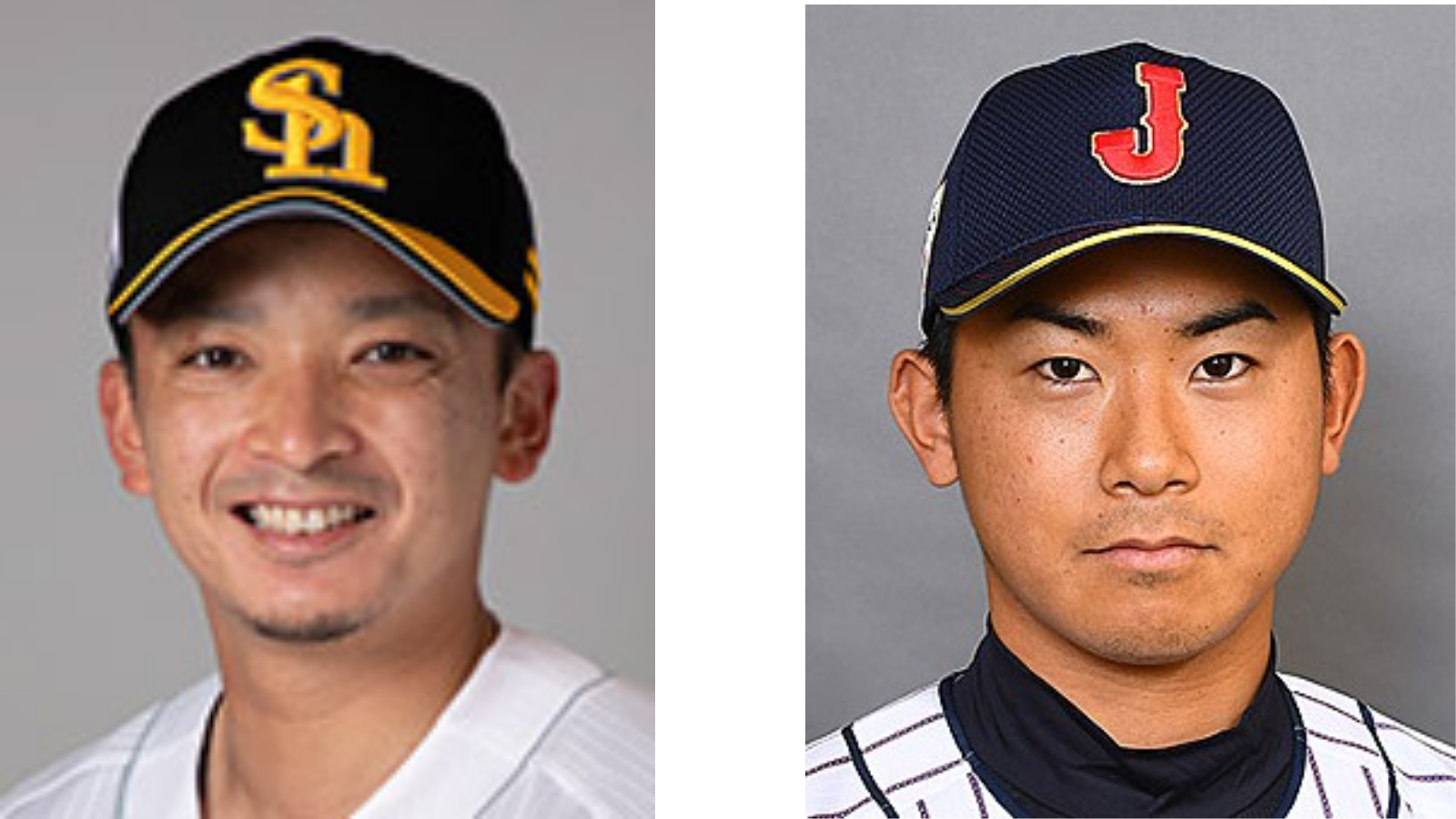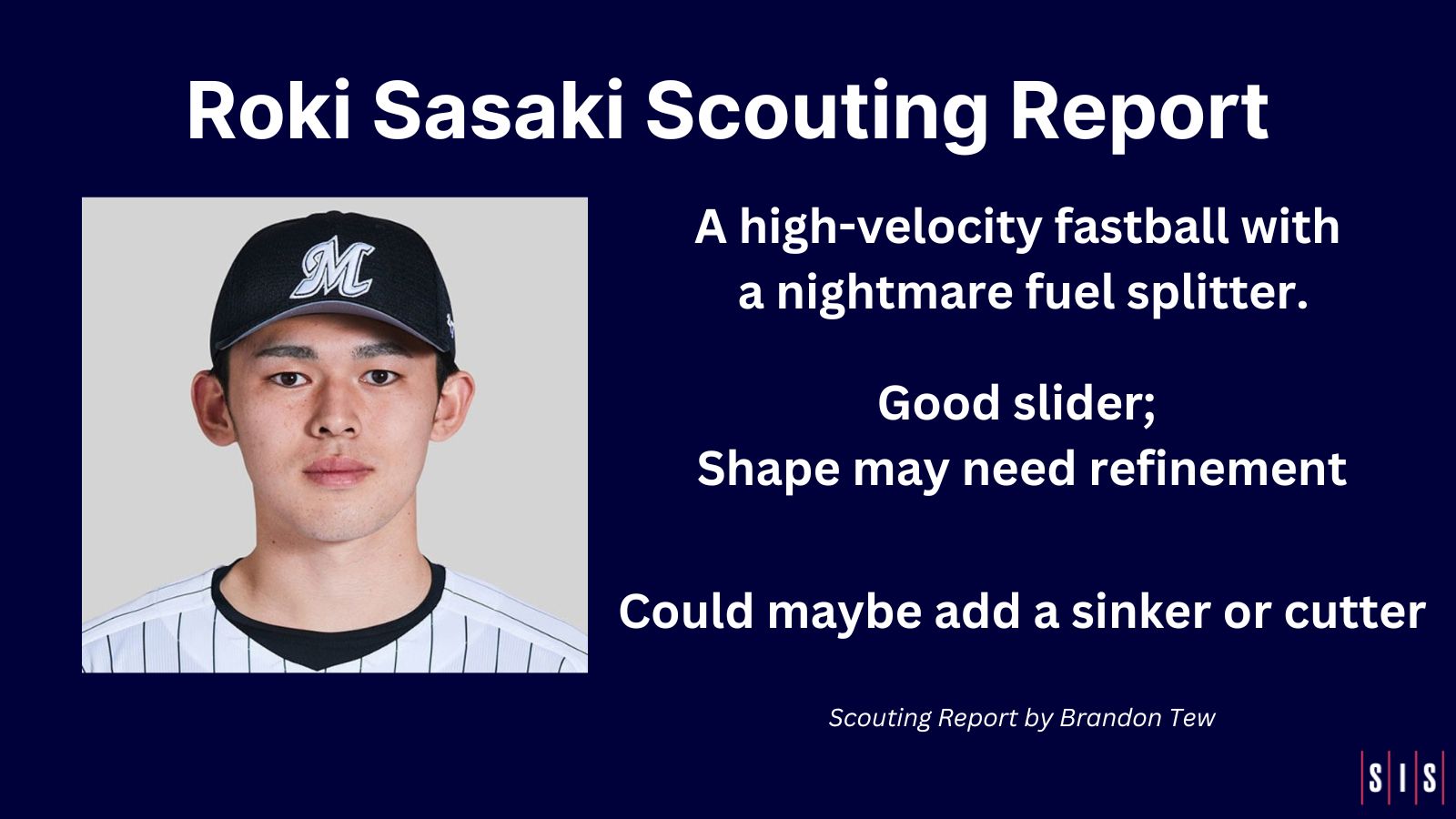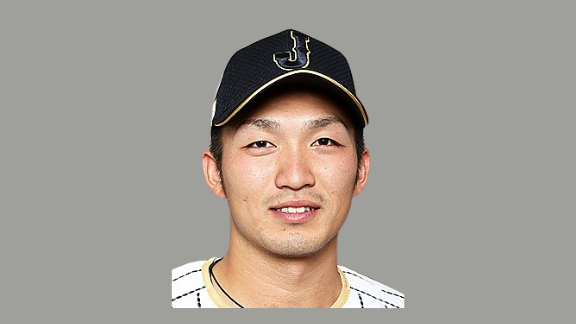Rōki Sasaki is one of the best pitching talents on the planet with a combo of nasty stuff and good command. He has obliterated his competition in Japan for three seasons now. He firmly holds the title of the best pitcher in NPB after Yoshinobu Yamamoto signed this offseason with the Los Angeles Dodgers.
| Season | IP | ERA | Strikeouts | Walks | K-BB% |
| 2022 | 129 1/3 | 2.02 | 173 | 23 | 30.6% |
| 2023 | 91 | 1.78 | 135 | 17 | 34.2% |
Sasaki has made his MLB aspirations known to the Lotte Marines, but for now, he will continue to torment hitters for at least one more season in Japan. Sasaki’s biggest hurdle is staying healthy throughout an entire season and continuing his stellar production. Sasaki most recently missed two months with a left oblique injury in late July before pitching sparingly with 3 more starts in September and October.
I’ve watched all of Sasaki’s starts the last 2 seasons and from that I’ve made the following evaluation:
What makes him so special?
Sasaki’s exceptional fastball and splitter allow him to be a dominant two-pitch pitcher using his devastating splitter off of his triple-digit fastball. Sasaki added in a good slider during 2023 but continued to lean on his fastball over half the time.
His command of the fastball and consistency in throwing his splitter below the zone have batters guessing and whiffing a bunch. With a 51.5% whiff rate on his splitter last season it’s one of the best pitches in Japan, if not all of baseball.
Mechanics
Sasaki shows explosive athleticism out of a wiry frame on the mound while throwing exclusively out of the stretch. Working from the third base side of the rubber as a right-hander he picks up his front leg and brings it high into the air with his knee finishing close to shoulder height for his 6’2” frame.
With his leg and foot out in front of him and a slight knee bend, he points his toes to the sky. He creates momentum down the mound with his leg and knee returning to his chest. He’s coiling and counter-rotating his hips during this initial move forward. With his foot turned towards center field, he leads with his front hip in a drop-and-drive delivery sinking into his back leg. He stays closed throughout this move down the mound.
At foot strike his arm doesn’t always get to 90 degrees, but the hip-to-shoulder separation he creates with his chest facing third base and his hip towards the plate is good. He sequences extremely well, letting the energy flow. A firm lead leg block, allows him to transfer energy to his arm. Throwing with a smooth and rhythmic delivery, he’s letting his body flow athletically to rip the baseball from a 3/4 arm slot.
The Arsenal (2023 usage and Average Velocity)
Fastball 50.3%, 99 mph
Sasaki’s fastball is one of two unicorn-type pitches for him. The average velocity is hard to match, as his four-seamer would have put him second among qualified starters in MLB last season behind only Bobby Miller who averaged 99.1 mph on his four-seamer last season. Sasaki’s fastball has also touched 102.5 mph. He showcased his electric fastball on the world stage during the World Baseball Classic last March.
Roki Sasaki has thrown 20 fastballs. Here is the velocity on them.
101.8
101.7
100.9
100.9
100.8
100.8
100.7
100.7
100.6
100.5
100.5
100.5
100.5
100.5
100.4
100.3
100.2
100.2
100.1
97.4Yes, you’re seeing that correctly: 19 of 20 at 100 mph-plus. Average velocity: 100.5 mph.
— Jeff Passan (@JeffPassan) March 20, 2023
To go along with the velocity is a deadly combo of vertical movement and horizontal run. The pitch has over 19 inches of IVB (induced vertical break) and 15 inches of horizontal movement arm side. He can carry the ball through the top of the zone, creating an elite pitch.
Sasaki routinely throws his fastball toward the upper third of the zone, with hitters swinging underneath the pitch in all quadrants of the zone. When he does pitch down in the zone the run on the pitch creates weak-contact grounders as well. The pitch is jamming righties, or moving away from lefties as he spots it down and arm side.
The fastball garnered a 24% whiff rate last season and a 56% GB rate. Hitters would sit on the pitch as it was their only chance to pick up a hit. He surrendered only 1 home run with it all last season and his fastball had a .592 OPS against with a .222 batting average against.
Sasaki will usually try to keep his fastball away from hitters and, even with the run he gets, he locates the pitch glove-side on the outer part of the plate consistently to righties. Against better left-handed hitters he will also target the inside part of the plate underneath the hands. He starts the pitch a couple of inches off the plate and tries to bring it back to the edge.
Sasaki just needs decent command of the pitch. When he wants to, he can dot a fastball on the corner. However, most of the game he challenges hitters in the zone and will split the plate in half vertically or horizontally.
The pitch has ridiculous velocity and movement, and he just needs to fill up the zone like a buffet plate. His catchers sometimes set up in the middle of the plate just to get him back into the zone.
Splitter 33.9%, 89.7 mph
Sasaki’s splitter is his best pitch and it might be the best splitter in the world. It rivals Kodai Senga’s ghost fork and racks up the whiffs and chases at an astronomical rate. Sasaki’s splitter had a 51.5% whiff rate in 2023. By comparison, Senga had a 52.3% whiff rate on his forkball in his 2022 NPB season.
Sasaki’s splitter darts toward the ground at the last second, as it holds plane with his fastball. It creates a tunnel effect that is hard to decipher, especially down in the zone with his four-seam. Randy Arrozarena experienced this when Sasaki faced him in the WBC.
Roki Sasaki, 92mph Splitter and 102mph Fastball, Overlay. pic.twitter.com/EIf8bh6Qdf
— Rob Friedman (@PitchingNinja) March 21, 2023
Sasaki peppers the bottom of the zone with the pitch but also will leave it up versus left-handed batters occasionally trying to steal called strikes or just throwing a pitch that slips and catches too much of the zone. Sasaki still has a consistent feel of the pitch, even with its volatile nature in movement.
In what I have decided is intentional to some extent, Sasaki will cut the splitter to his glove side away from right-handed batters, and pronate more to fade it away from lefties. He does this often enough to almost have a feel for his finger pressure on the pitch, though I can’t confirm this. The pitchability he displays with this specific pitch makes him a unique oddity in baseball and his consistency with it is just as impressive.
This video from Pitching Ninja earlier shows the cut Sasaki can create on his splitter and how hard it is to barrel the pitch as a right-handed batter.
Sasaki’s Splitter isolated. pic.twitter.com/IzzK5iWibl
— Rob Friedman (@PitchingNinja) March 21, 2023
With a 70.5% GB rate and an absurd .272 opponents’ OPS along with a .101 batting average against, the pitch is an unhittable menace.
Slider 14%, 87.5 mph
A pitch that Sasaki has been working on as a reliable third pitch is his slider. In 2022, he used his curveball and slider at around 5 percent each, but last season he upped his slider usage to 14 percent and scrapped his curveball.
He mainly targeted the bottom of the zone, glove side with his slider, and used it primarily to righties to keep them off of his splitter and fastball. He did have inconsistent command of the pitch at times but it became a pitch that he would routinely feature throughout a game as a wrinkle.
Roki Sasaki, playing with the slider that Yu Darvish helped him develop
— Yakyu Cosmopolitan (@yakyucosmo) June 4, 2023
Sequence to LHH (Slider backdoor, Fastball in, Splitter Down):
The pitch has great projectability and when he snaps one off it can be a nasty breaker with sweep and velocity, with a 47% whiff rate in 2023. The next step for him is continued belief in the pitch. With how good his first two pitches are, he doesn’t need to up the usage that much more from where it currently sits in his repertoire.
Roki Sasaki’s arsenal in slow motion 🤩
Fastballs: 100 mph, 101 mph
Splitters: 92 mph, 91 mph
Sliders: 89 mph, 90 mphPitches from his 11-strikeout gem to outduel Yoshinobu Yamamoto pic.twitter.com/3WqftblbwY
— David Adler (@_dadler) April 14, 2023
It’s worth mentioning that Sasaki has a curveball that sits at 80 mph but he threw the pitch only twice last season. He used to throw it more as a strike stealer early in counts but has all but scrapped it.
What to Expect this season.
Sasaki’s utter dominance should likely continue in 2024. There are no flaws in his game other than staying healthy and on the bump. When he’s pitching there’s nobody better than him in NPB and the 22-year-old phenom will likely be the most exciting pitcher to watch come this spring. As for his future in Japan and possible move to MLB, that will have to wait for now, but he’s sensational to watch every time he pitches.



